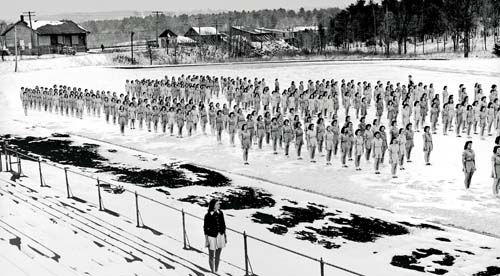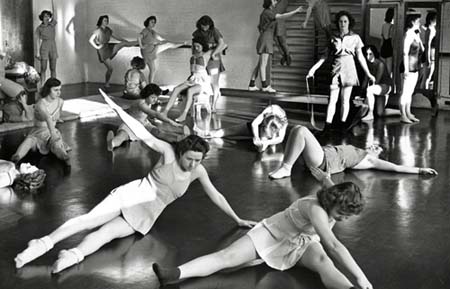 |
 |
| current issue |  | past issues |  | send a letter/news |  | address update |  | advertise |  | about us |  | alumni home |
Features
|
Call to Action
A World War II fitness program put UNH in the limelight. By Kristin Waterfield Duisberg Also read The Saga of Life, a story from The New Hampshire Alumnus |
Make a comment |
It was cold.
That's the unanimous recollection of a handful of alumnae from the classes of 1944-1946 who took part in a Life magazine photo shoot in December 1942 to document a new UNH fitness program for women. Some remember that it was exciting. Others that it was fun. Foolhardy. Exhausting. But above all else, it was cold.
Like other colleges around the country in 1942, UNH was a campus almost devoid of male students, the majority of whom had gone off to basic training for World War II or were already fighting overseas. Along with their books and letter sweaters, however, the men also left behind the conditioning equipment they'd used for training, which lay untouched until Margaret Hoban, director of women's physical education, stepped in.
 |
Hoban devised a fitness program to prepare female students for possible service in the women's armed forces auxiliaries. For at least three hours weekly, freshmen, sophomores and juniors did drills to increase their strength and agility, including calisthenics, hiking and obstacle courses.
Doris Flynn Grady '44, a physical education and biology major from South Berwick, Maine, remembers the program well. "The exercises we were doing were essentially the ROTC program, tailored for women," she says. "Those of us who were phys-ed majors really thrived on it."
As the first organized effort of its kind in the country, the UNH fitness program caught the attention of other colleges looking to prepare their "girls" for possible wartime service. It also caught the attention of the editors of Life, who on Dec. 17 sent famed photographer Alfred Eisenstadt to Durham to catch some 650 undergraduates in action.
Although the temperature was below freezing and a heavy snow had fallen several days earlier, Eisenstadt wanted to take photos outdoors. UNH obligingly shoveled Memorial Field and cleared snowdrifts from the obstacle course. The students shed their jackets and ski pants to run, jump, crawl and climb wearing light-blue gym suits and canvas sneakers. It was cold.
The seven-page story in the Jan. 11, 1943, issue of Life sparked interest from Hollywood newsreel editors. For two days in mid-January, the students repeated the arctic exercise routines, this time before movie cameras. The experience was "a huge morale booster," says Anita Smith Greenbaum '45. "The campus had become such a different place with most of the boys gone, and it seemed like every day the letters were coming about someone you knew who had been killed. Taking part in this program really felt like we were doing something of significance to contribute to the war effort."
 |
Greenbaum is one of several alumnae who speak eloquently about the extent to which World War II cast a shadow over the daily lives of Americans. At UNH, the academic year was accelerated to allow students to graduate in three years, and coeds were required to take war-related courses such as drafting or welding.
Grady, who went on to teach physical education and other subjects in the Dover, N.H., school system, recalls that the iconic "We Can Do It!" poster of Rosie the Riveter reflected a real attitude. "We all had jobs and took extra courses and contributed in any way we could think of to support our country," she says.
After the war ended in 1945, the G.I. Bill helped veterans pay for college, and they returned to campus in droves. Climbing four-foot fences "commando style" gave way to skiing on Beech Hill and jitterbugging at The Notch. But hundreds of alumnae left Durham with vivid memories of the time they ran "on the double!" across snowy fields for Uncle Sam. ~
Kristin Waterfield Duisberg is a writer and editor for UNH's Editorial and Creative Services and the author of a novel, The Good Patient.
See the following pages for more personal stories.
blog comments powered by Disqus

